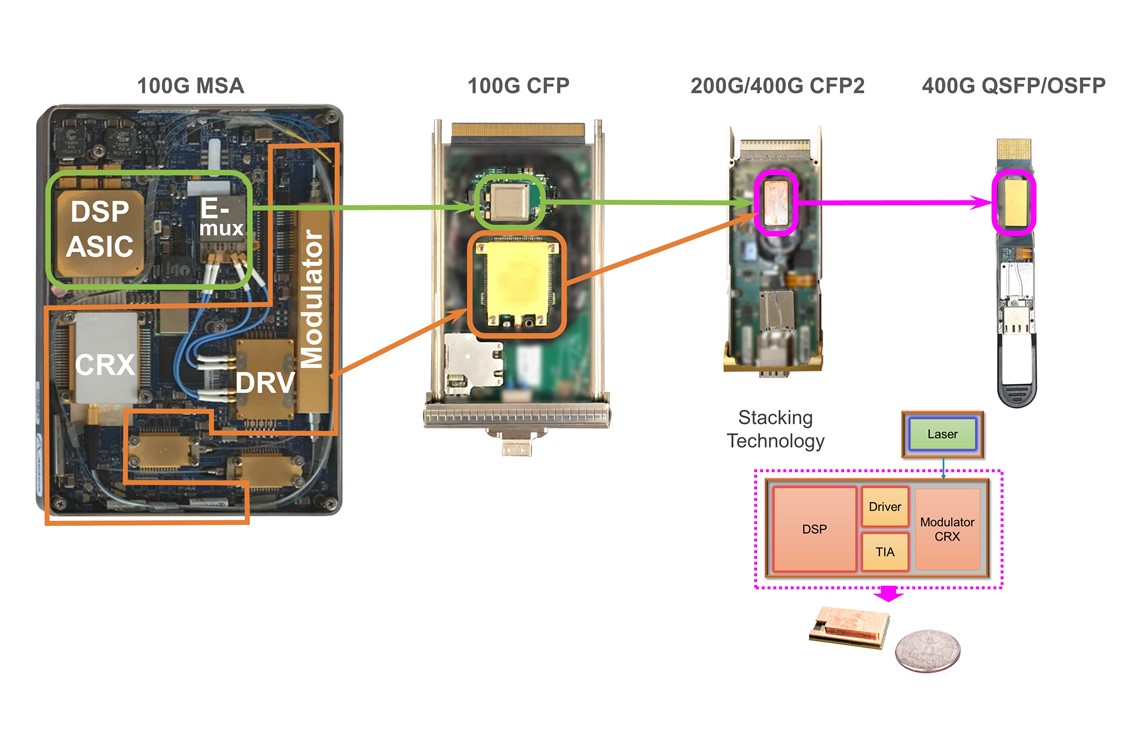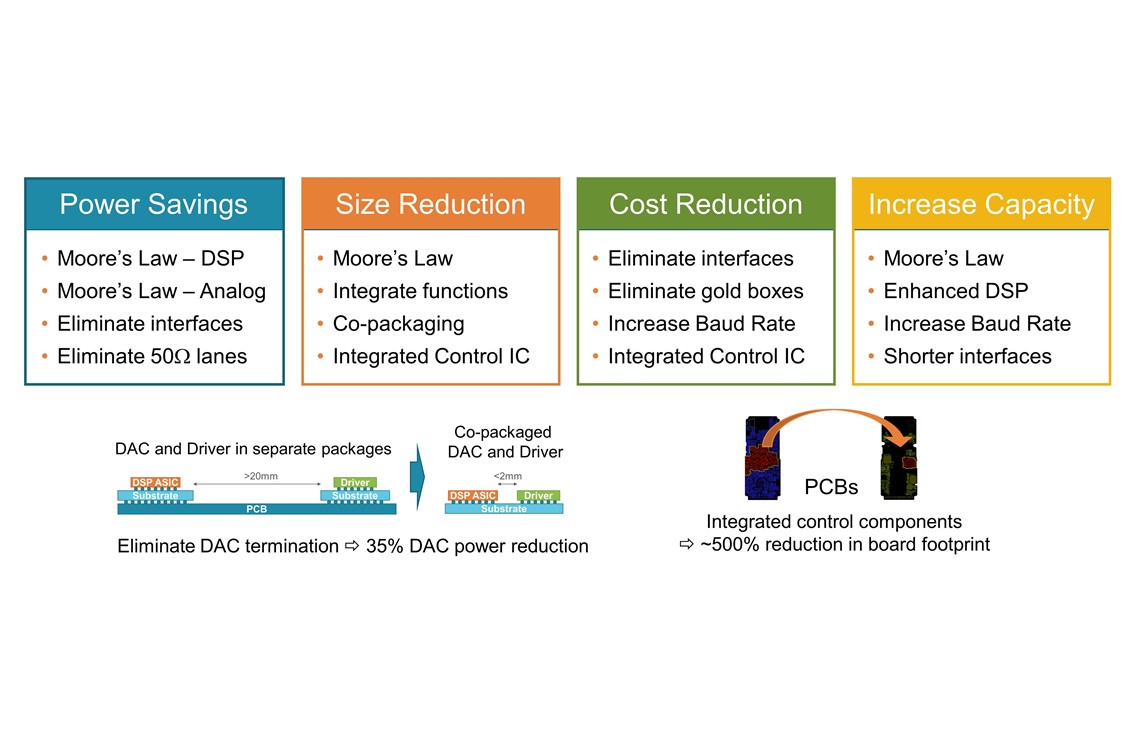Eugene Park discusses the opto-electronic integration approach to ensuring networks continue to meet bandwidth demands
With network capacity demands expected to grow 25-30 per cent per year, driven by applications such as self-driving cars, augmented reality, internet of things (IoT), and 4k/8k video streaming content, network operators are challenged with an ongoing need to deploy solutions that are able to keep up with these capacity demands while being, power, size, and cost efficient.
More specifically, these innovative applications are increasing the bandwidth demands towards the edge of the network, motivating the trend towards coherent technology for optical interconnects expanding from the transport portion of a network toward the edge, and from large form-factors to smaller ones. Opto-electronic integration—miniaturisation of optical and electrical circuitry and components— is a key approach to address these optical networking trends. It not only enables an increase in capacity, but also reduces the size, power and cost of optical devices.
Standardisation efforts in the optical networking industry have strongly supported these trends. As an example, the Optical Internetworking Forum (OIF) has been driving an effort to standardise a solution known as the 400ZR implementation agreement, with a goal to combine optical line-side fibre capacity in the same form factors as client-side solutions to deliver 400G Ethernet links for edge data centre interconnect (DCI) applications. 400ZR addresses edge-DCI applications with link distances targeting up to 120km and can be implemented in pluggable 400Gb/s optical transceiver module form-factors used for client optics such as quad small form factor pluggable double-density (QSFP-DD) and octal small form-factor pluggable (OSFP). These small form factors present a challenge of integrating coherent technology into a very compact footprint.
Industry efforts for reaches and features beyond 400ZR have also been proposed, including OpenZR+ which borrows features from the Open ROADM carrier-centric standard. In all of these efforts, regardless of the standard, a high-level of opto-electronic integration is required to achieve their goals.
Integration through co-packaging techniques can help to scale network capacity and reduce costs in three areas: transport, ‘short reach’ and intra line card. For optical transport, high-capacity links typically use coherent technology for its ability to support multiple hundreds of gigabit capacity per carrier. However, as performance of these solutions approach Shannon’s Limit, it is becoming more difficult to increase capacity and reduce cost per bit by primarily focusing on increasing the modulation order. Beyond the coherent modulation order of 64-QAM, the achievable link distance begins to shrink dramatically, which leaves higher baud rates and advances in packaging technology as preferred ways to increase capacity and decrease cost-per-bit.
Coherent transmission and integration
The importance of opto-electronic integration can be seen in Figure 2 which shows how the size of a coherent transceiver with its many key components has been significantly reduced over many years.

Looking back in time, the original 100G Multi-Source Agreement (MSA) module from 2010/2011 had many discrete components, but the 100G CFP module integrated the modulator, drivers, and receiver into a compact gold box. Integrating the digital signal processor (DSP) and optics into one common package reduced the footprint by another factor of two. This integration has enabled significantly higher density coherent solutions, and is expected to support 400ZR, OpenZR+, and OpenROADM applications.

In intra-data centre architectures today, hyperscalers are driving new technology and speeds, requiring a trend towards multi-level modulation (e.g., PAM4) with 400G DSPs. Opto-electronic integration technologies are already benefiting intra-data centre solutions, including advanced integration, silicon photonics and component stacking techniques.
As data rates increase, coherent detection may become more competitive in intra-data centre applications. Compared to direct detect 4-level pulse-amplitude modulation (PAM4), coherent implementations have similar complexity. Both approaches require a DSP and four lanes of optics, drivers and transimpedance amplifiers. At higher data rates, coherent can benefit from higher link margin, as well as the use of a single laser. Coherent cost structures would benefit from these high-volume applications, which also do not require the costly tunable laser technology currently used for coherent in transport networks.
Switches: challenges and trends
Switch ASICS are also increasing in capacity in the data centre. However, to keep the pin count under control, lane speeds of the switch I/O need to be increased. This increases electrical losses and demands more equalization, which increases the power consumption. Serdes connections from the switch to the front panel can consume up to 6pJ/bit. While 400G modules may address switch capacities of 12.8T, faceplate pluggables may become more challenging with 25.6T and 51.2T switch platforms.
One potential way to address these density issues is to co-package the optics and the electrical switch and put them on a common substrate. For example, a 51.2T switch could be placed on a common substrate with 16 chiplets, where each chiplet supports up to 3.2Tbps. By putting the optical interfaces very close to the switch, a shorter reach interface can be used that consumes significantly less power. The chiplets could also be pluggable, making them field replaceable and capable of supporting various interfaces that may be direct detect or coherent.
As described above, opto-electronic integration has already enabled cost-effective scaling of capacity and density in optical networks, and we expect the benefit to continue from smaller CMOS nodes well beyond the current 7nm today. While opto-electronic integration techniques are in the early phases, they are already bringing significant value to the optical interconnect market. This has enabled smaller form factors and we expect this trend to continue.
There are other applications beyond optical networking in which opto-electronic integration can provide benefits such as optical coherence tomography, LiDAR and deep learning, among others. Opto-electronic integration is anticipated to become a key technology in the future, and the industry has only begun to tap its potential power.
Eugene Park is senior manager, technical marketing at Acacia Communications


